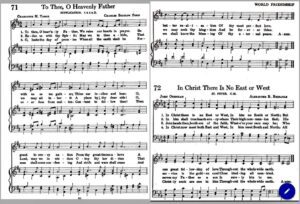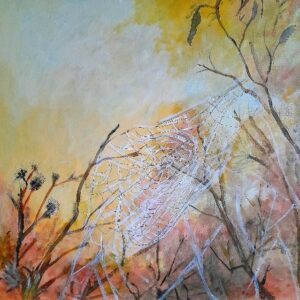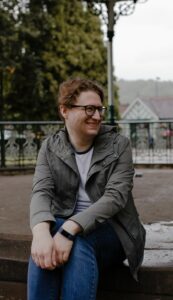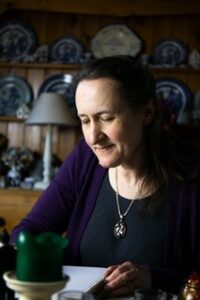
Charlotte M Yonge (1823-1901) spent her life in Otterbourne, Hampshire, and is being rediscovered in the 21st century for her significance as a novelist and editor. In this blog post, Ruth Carlyle and David Barton explore the complexities of identifying her hymns and poems and setting Yonge’s words to music that respects Yonge’s heritage whilst being relevant to contemporary audiences. The blog closes with links to recordings of new settings by David Barton of ‘To Thee, O Heavenly Father’ and ‘The Gossamer Spider’, commissioned by Ruth and Nic Carlyle, in recordings by David Barton and Ruth Carlyle.
The first performance of a choral version of David Barton’s setting of Yonge’s ‘To Thee, O Heavenly Father’ will be given by the Wayneflete Singers as part of a bicentenary evensong for Charlotte M Yonge at Winchester Cathedral on 11 August 2023.
The distinctive blue and gold spines of the Macmillan editions of Charlotte M Yonge’s novels continue to grace the shelves of second-hand bookshops, indicating the scale of the publication and reprinting of her works in the 19th and early 20th centuries (Walker Gore, Schulze and Courtney (eds), 2023). Poems and hymns by Yonge, however, can be harder to identify, as much of Yonge’s own poetry is written “in character” and Victorian hymnals do not always attribute authorship for hymns.
Yonge’s poetry
Yonge includes poetry and commentaries on poetry in her novels. Some of the poems she wrote for her characters were intended to give insights into the fictitious writers of the words – such as nonsensical lines by Constance Hacket in her attempts at poetry in Two Sides of the Shield.
Charlotte M Yonge is, nonetheless, a Hampshire poet in her accounts of local countryside and the changing times, such as her poem ‘Old Remembrances’, which she describes in John Keble’s Parishes as “half parody, half original”. This poem includes insights into the postal services at Otterbourne before the Penny Post, local occupations and church customs.
Yonge rarely provides an authorial voice in her writings, expecting readers to draw their own conclusions both on extracts in verse and the implications of views expressed about specific poems by different characters. The closest she comes to giving opinions on reading poetry is in her play-like publication Aunt Charlotte’s Evenings at Home with the Poets. As Aunt C, she interprets poems for the children and provides her own verses within the collection in the interest of balancing the content on each theme.
Her poem ‘The Gossamer Spider’ is included in a section on ‘The Spider’ by way of a positive counterbalance to more negative views of spiders in better known poems, following on from Mary Howitt’s ‘Spider and Fly’ (‘”Will you walk into my parlour?”/Said the Spider to the Fly’). The emphasis in Yonge’s poem is on the beauty of the webs spun by the spider.

Yonge includes music and musical settings of poetry in her novels, as well as hymns, and in Aunt Charlotte’s Evenings at Home with the Poets the character representing her niece Alice exclaims over one of the poems, “Is it not pretty? I must find a tune for it and let the Infant School children sing it”. We hope, therefore, that Yonge would have approved of music being set to her own words.
Locating Yonge’s hymns
John Julian’s ambitious 1907 A Dictionary of Hymnology: setting forth the origin and history of Christian hymns of all ages and nations; revised edition, with new supplement credits Charlotte M Yonge with the authorship of two hymns (p. 1299). These are: ‘Into Christ’s flock we are received’, a hymn for holy baptism; and ‘Why lived I not in those blest days?’ a text on the complexities of believing what we cannot see, as a hymn for St Thomas’ day.
Both of these hymns are taken from The Child’s Christian Year: hymns for every Sunday and Holy-days; compiled for the use of Parochial Schools. This volume owes its creation to Charlotte M Yonge’s mentor John Keble and was collated anonymously by Charlotte’s mother, Frances Mary Yonge. Authorship is not attributed for any of the hymns in The Child’s Christian Year. Margin notes by John Ellerton and Charlotte M Yonge in the digitised third edition, however, identify Charlotte as the author of one hymn in addition to those cited by John Julian: ‘When Israel left the Egyptian’s land’.

All three sets of words in The Child’s Christian Year are intended to be used as reflections on specific days of the year and are lengthy compositions to set to music. A shorter and more general hymn by Yonge appears, with full credit, in The Boys and Girls Hymnal of 1945, edited by Bird Parker and Darlington Richards. This hymn, ‘To Thee, O Heavenly Father’, is the one we selected to set to music for Charlotte M Yonge’s bicentenary.

Setting Yonge’s words to music
Perhaps it is unfair to label Yonge’s words to be ‘of their time’? Yet, they are firmly rooted in the Victorian tradition with which we are familiar. Setting words which are, shall we say, fairly conventional, to music, presents its own particular challenges and isn’t necessarily as easy as one might think. How do we take texts of over 100 years old, stay true to them, but set them to music in a way which gives fresh insight and interest to modern ears?
‘The Gossamer Spider’ was, perhaps, the trickiest to set to music. Whilst the poem is blessed with beautiful imagery and atmospheric word painting, it did not necessarily lend itself to an obvious musical meter. Originally a poem for children, David had to approach it from the perspective of creating a musical setting to be sung most likely by adults. How does one avoid the clichéd nursery rhyme feel, whilst embracing the childlike qualities of the poem itself?
As any composer will tell you, putting the creative process into words is not easy. In setting ‘The Gossamer Spider’, David sought to take the text and create a web of music which took the listener on a journey which weaved, not just in and out, but up and down too. That sense of spinning and weaving is particularly evident in the chromatic passages which conclude the first three verses.
‘To Thee, O Heavenly Father’, written originally as a hymn, was considerably easier to set to music. The accompaniment provides flow and drive to the arching nature of the vocal line. Whilst not necessarily childlike, David could imagine hearing it sung by children, the vocal lines demanding a purity of tone which befits the original Victorian text. Whilst putting a modern ‘twist’ on the original hymn text, its simplicity retains and conveys Yonge’s message.


We enjoyed identifying and setting Yonge’s poetry to music for her bicentenary year. Ruth sang both of the songs with David at the piano for recordings at the Summerfield Studio. We hope that the songs will be of interest to people who are interested in the works of Charlotte M Yonge and Victorian literature more widely.
You can use these links to listen to Ruth Carlyle and David Barton’s recordings of the settings by David Barton of ‘Charlotte M Yonge: The Gossamer Spider’ and ‘Charlotte M Yonge: To Thee, O Heavenly Father’, or search for them on your preferred music platform.
Further reading:
Anon. The Child’s Christian Year: hymns for every Sunday and Holy-days; compiled for the use of Parochial Schools; third edition (Oxford: John Henry Parker, 1844) [edition with marginalia, accessed online 10 April 2023 https://www.google.co.uk/books/edition/The_Child_s_Christian_Year_Hymns_for_Eve/8MNVAAAAcAAJ?hl=en&gbpv=1&dq=The+Child%27s+Christian+Year&pg=PP1&printsec=frontcover ]
Bird Parker, Caroline and Darlington Richards, G. The Hymnal for Boys and Girls (New York: D Appleton-Century, 1945) [available on digital loan by the hour https://archive.org/details/hymnalforboysgir0000caro ]
Julian, John (ed) A Dictionary of Hymnology: setting forth the origin and history of Christian hymns of all ages and nations; revised edition, with new supplement (London: John Murray, 1907) [accessed online 24 March 2023 https://ia601201.us.archive.org/23/items/b24850998/b24850998.pdf ]
Walker Gore, Clare, Schultze, Clemence and Courtney, Julia (eds) Charlotte Mary Yonge: Writing the Victorian Age (London: Palgrave Macmillan, 2023)
Yonge, Charlotte M. Aunt Charlotte’s Evenings at Home with the Poets: a collection of poems for the young, with conversations, arranged in Twenty-five Evenings (London: Marcus Ward & Co, 1881) [available online https://archive.org/details/auntcharlottese00yonggoog ]
Yonge, Charlottte M. ‘Old Remembrances’ appears both in John Keble’s Parishes: a History of Hursley and Otterbourne and Old Times at Otterbourne
Author: Dr David Barton

Bio: As an instrumental teacher and mentor, David has worked passionately within the field of music education for over 20 years. As a composer and arranger, David has over 100 works published in the UK and overseas. He writes a successful blog and contributes to a number of print publications. Following an MEd at The Open University, David is an active researcher in the field of music education, having completed a PhD at the Royal College of Music, London. He has been a Research Consultant for ABRSM, a Graduate Teaching Assistant at the RCM, and a syllabus consultant for ABRSM and LCM Examinations.
Twitter: @davidbartonmus
Website: https://www.davidbartonmusic.co.uk/
Author: Dr Ruth Carlyle

Bio: Ruth Carlyle works as Head of Knowledge and Library Services as part of a national team at NHS England, overseeing professional leadership and quality assurance for local NHS libraries. Her academic interest is in evidence for decision making and her PhD is on the politics of public involvement in decision making in the NHS. She has an interest in archives and Victorian literature and is a member of the Charlotte M Yonge Fellowship. Ruth has a DipLCM in classical singing and writes poetry and music lyrics, including creating and recording music with David Barton.
Twitter: @RuthCarlyle
Music website [no account needed to listen]: https://soundcloud.com/ruthcarlyle

